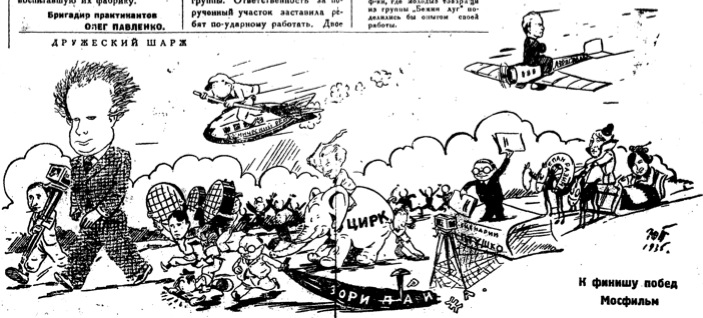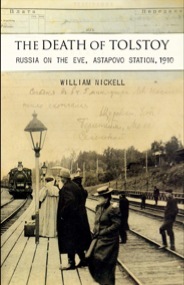Racing Films and a Lagging Industry: Soviet Cinema in 1935

The use of this year as a rubric for a film series was justified on several counts, not least of which was the Soviet film industry’s transition to sound. The first film we watched, The Private Life of Petr Vinogradov (actually from 1934) brought this question immediately to our attention. Its action seems “audiological,” as if structured around sound highlights, which include numerous musical performances and a hero who loves to declaim his own doggerel verse. A rousing score by Lev Knipper repeatedly overpowered the visual aspects of the film. Our second film, Space Flight, though released the following year, was silent, reminding us that we were exploring a transitional stage in the development of Soviet sound cinema.
The period in question also represented the months immediately following the August 1934 Congress of Soviet Writers. This was a major turning point in the history of Soviet art, heralding the adoption of socialist realism as the dominant aesthetic program. Film would be expected to follow the same guidelines as literature in offering the “historically concrete depiction of reality in its revolutionary development,” as the Literary Gazette explained on September 4, 1934. In January 1935 a national cinema conference was convened that has been likened to the Writers Congress in terms of its effect upon the film industry.
We could see the impact of these events in the narratives of our films, but also in the press coverage of their production, which we traced in one of the microfilmed periodicals in Regenstein, For Bolshevik Film. The paper describes growing pressure to complete films according to production plans. This was of special interest when we watched The New Gulliver, the first full-length stop-motion animation film ever made. The director, Aleksandr Ptushko, reported that in the course of the year 1934 they had not taken a single day off from work on the film, and shot 10-12 hours each day. His description of work on the project is itself a classic socialist realist narrative: deprived of the needed materials, facing a seemingly impossible deadline and sabotaged by an incomplete script, the collective nonetheless completed the project on schedule, “without lowering its quality.” Members of his crew acknowledged that Ptushko served “not only as director, but also as artist, designer, constructor, animator, and as an example of a tireless worker, organizer, and comrade who infected the entire group with his enthusiasm.” As a result, the whole crew had been “seized by the spirit of socialist competition and strike work.” Because the film was so technically complex and involved the cooperation of numerous crews, it was championed in the press as an example of how Soviet film production might best be organized. The film factory was also a model for other industries: indeed, this triumph of collective labor, guided by singular leadership, was the stuff of both narrative and political fiction throughout the year.
While each Soviet industry had its own variant of the production narrative, cinema had the advantage of depicting victories that were not always occurring in real life. The second film that we watched, Space Flight, had faced its own series of production difficulties. Like New Gulliver, it involved complex shooting assignments, including animation, some primitive flight simulation and depictions of zero gravity motion. The spaceship’s cabin had been 33 days late in preparation, and even then its decoration was not complete. These difficulties were eventually overcome and, with the help of consulting rocketry pioneer Konstantin Tsiolkovsky, the film was launched in time for the October anniversary of the Revolution. It depicts a successful moon landing, and though the crew’s return flight is in doubt, it too is pulled off in the end (an inevitable outcome, given that the ship had been christened Iosif Stalin).
Many films were not meeting their deadlines, however. In order to instill a sense of urgency, the major film factories challenged one another to sotssorevnovanie, or socialist competition, throughout the year. Progress in these races was covered extensively in For Bolshevik Film. On April 29 the crew of Circus issued a public challenge to Eisenstein and the makers of Bezhin Meadow, which was accepted. A political cartoon from the period shows Eisenstein and his cameraman Tisse outpacing the airplanes, rockets and elephants of competing films (Aerograd, Space Flight, Circus, Dawn in Paris and Stepan Razin). The production supervisors of Bezhin Meadow offered an editorial letter promising to exemplify the ideals of Soviet labor in making their film, but also to assist the larger Mosfilm collective in achieving “Bolshevik tempo, socialist quality, and victory in their competition with the other studios.” The irony of this promise lies in the fate of their film. Bezhin Meadow ran into numerous difficulties with the censors, was delayed for many months and eventually destroyed.
In September 1935 Aleksei Stakhanov would give a new name and face to the shock-worker movement, but it had been a theme throughout the year. In June it was noted that the crew of Ball and Heart had completed over 15 minutes of sound production in a single 8½-hour shift, far exceeding the norm of 3-4 minutes per day. The article reporting this feat suggested that it demonstrated how better planning and organization could raise the norm for sound production to 9 minutes per shift. Such efficiencies were often the currency as production imperatives took on a purely quantitative nature. Great emphasis was placed on the responsibility of the entire film industry to meet the quotas set forth in the annual plan, the deadline for which was December 15.
As the date approached, it became increasingly clear that the industry’s overall goals would not be met. The year ended with handwringing and rethinking. Boris Shumyatsky, who during the summer had toured Hollywood and Europe to study production methods, would play a leading role in plans to reorganize based on the Hollywood studio model. When industry executives convened to set production goals for the coming year, he explained the role of a Tinseltown producer. At the same time as the content of Hollywood films was being derided as an American national disaster in Ilf and Petrov’s account of their own U.S. tour, the efficiency with which they were produced was presented as a model.
In a September front-page article entitled “We Can” Eisenstein had insisted that films could be made quickly, arguing that delays were caused not by technology, but by people. Another of our films, Alexander Andrievskii’s The End of Sensation, touched directly on this problem. Based on a Karel Capek play, it presents a tale set in the west, in which robots begin to replace humans who have proven too slow on an assembly line (which, as it happens, is circular and looks like a film reel). In one of the most striking scenes in our series, the robots, which are controlled by sound, dance hypnotically to the saxophone improvisations of their creator as he realizes that he is in danger of losing control of his invention. At the film’s end, his capitalist sponsors direct the robots to attack the striking workers they have replaced. The danger of efficiency as an end in itself was clear in this film, but throughout the year it seemed that the Soviet film industry was itself struggling to master the machine it was creating. The long delays with Bezhin Meadow would remind everyone that the objectives toward which they strived were still not always clear, even to those who had taken the lead in expressing them.



